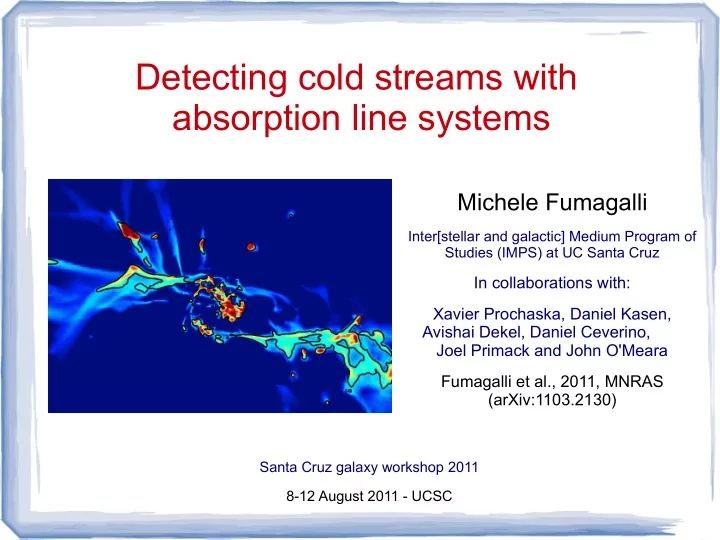

Detecting cold streams with absorption line systems Michele Fumagalli Inter[stellar and galactic] Medium Program of Studies (IMPS) at UC Santa Cruz In collaborations with: Xavier Prochaska, Daniel Kasen, Avishai Dekel, Daniel Ceverino, Joel Primack and John O'Meara Fumagalli et al., 2011, MNRAS (arXiv:1103.2130) Santa Cruz galaxy workshop 2011 8-12 August 2011 - UCSC
Predictions of cold accretion Simulations predict that cold gas (< 10 5 K) in narrow streams and satellites is the dominant source of fresh fuel for star formation at high-z (Katz et al., 2003; Kere š et al., 2005,2009; Dekel&Birnboim,2006; Dekel et al.,2009; Faucher-Giguère et al.,2011 )
Evidence of cold streams... + Katz and many others....
...with absorption line systems Complementary to Ly α in emission We need predictions on how cold streams look like as seen in absorption (Stewart et al. 2010; Faucher-Gigu è re & Ker ě s 2011; Kimm et al, 2011; MF et al., 2011; Rubin et al., 2011)
Numerical simulations We use high resolution (35-70 pc) AMR cosmological hydrodynamical simulations (Ceverino et al., 2009; 2010) using the ART code (Kravtsov, Klypin & Khokhlov 1997; Kravtsov 2003) MF et al., 2011 Ceverino et al., 2010 Stellar feedback is implemented and gives rise to outflows of hot gas with velocities of few hundreds km/s. The outflow mass flux is up to 1/3 of the inflow one.
Radiative transfer post-processing Sensible estimates of the neutral hydrogen require radiative transfer (e.g. Faucher-Gigu è re & Ker ě s 2011; Altay et al., 2010; McQuinn et al., 2011) The Monte Carlo RT code includes: Collisional ionization ● MF et al., 2011 UV background ● Stellar radiation ● Dust scattering and absorption ● (Kasen et al., 2006;2011) We obtain ≤ 10% escape fraction at the virial radius Local sources matter
How cold streams look like: ● Cold streams are mostly ionized ● The covering factor is below 25% at all redshifts ● Cold streams contribute to the LLS population ● Cold streams are metal poor (Z ~ 1% Z sun ) ● Cold streams exhibit moderate kinematics
1) Cold streams are ionized N H N HI CIE N H MF et al., 2011 N HI STAR N HI UVB
1) Cold streams are ionized N H N HI CIE N H I MF et al., 2011 N HI STAR N HI UVB
2) The covering factor is < 25 % Redshift At R vir , the covering factor is: (e.g. Dekel et al., 2009; Ker ě s & Hernquist 2009; Stewart et al. 2010; Faucher-Gigu è re & Ker ě s 2011) Optically thin gas 20 - 60% ● … but ... Ionized gas (LLS) 6 - 25% ● Galactic neutral gas 1 - 5% ●
3) The incidence is > 30% Surveys of systems in foreground of quasars probe the cross section and number density of absorbers, not just the covering factor. (e.g. P é roux et al., 2003; O'Meara et al., 2007; Noterdaeme et al., 2009; Prochaska et al., 2010) (cfr. Razoumov+2006; Nagamine+ 2007; Pontzen+ 2008; Tescari+ 2009; Cen+ 2010; Altay+2010; McQuinn+ 2011 )
4) Streams are metal poor Cold streams are metal poor (1% solar), albeit non primordial. The low metal content of cold streams is a key element to separate them from the ● more metal rich gas in outflows. (Prochaska et al., 1999; Cooksey et al., 2008; Kacprzak et al., 2010; Kimm et al., 2011;Ribaudo et al., 2011)
5) Kinematics are moderate Simulations with cold streams reproduce the observed kinematics of Ly α but underpredict the strength of low ionization metal lines (cf. Steidel et al., 2010; Powell et al., 2010; Kimm et al., 2011)
Are similar systems observed? While the population of LLSs is likely to trace gas in a variety of phases, the discovery of metal poor LLSs could be the first detection of cold streams (e.g. Prochaska et al., 1999; Tripp et al., 2005; Cooksey et al., 2008; Thom et al., 2011; Ribaudo et al., 2011) z < 1 Lehner+2011 (in preparation)
Current and future directions Prospects to reveal the cold mode of accretion are good Observational work should provide: ● The fraction of metal poor and metal rich LLSs ● Samples of galaxy-absorber pairs Future work with simulations should characterize: ● How cold flows and outflows coexist and interact ● The kinematics and incidence of low and high ionization metal lines Metal poor gas can be common at z~3, in line with model predictions
Recommend
More recommend